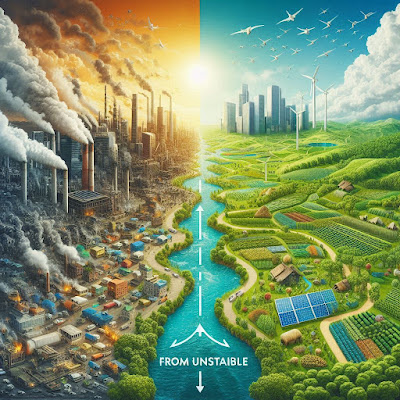The Club of Rome Model: Predicting Our Planet's Future
In the early 1970s, a group of scientists, economists, and industrialists known as the Club of Rome developed a groundbreaking model that aimed to forecast the future of our planet. The Club of Rome Model has since become a crucial tool in understanding the interplay between economic growth, resource consumption, and environmental sustainability. This blog post will delve into the history, key findings, and ongoing relevance of the Club of Rome Model.
What is the Club of Rome Model?
The Club of Rome Model is based on a report called "The Limits to Growth," published in 1972. This report utilized a computer simulation called World3 to analyze the long-term impacts of exponential economic and population growth on finite resources. The model considered various factors, including industrialization, population growth, food production, and resource depletion.
Key Findings of "The Limits to Growth"
The report's authors, including Donella Meadows, Dennis Meadows, Jørgen Randers, and William Behrens III, presented several scenarios based on different assumptions about resource availability and technological advancement. Here are the key findings:
1. Exponential Growth and Resource Depletion: The model showed that if current trends continued, the planet would reach the limits of growth within the next century, leading to a sharp decline in both population and industrial capacity.
2. Sustainable Development: The report suggested that it was possible to achieve sustainable development by stabilizing population growth and adopting technologies that reduce resource use and pollution.
3. Need for Immediate Action: One of the most important messages was the need for immediate action to shift from growth-centric policies to more sustainable practices. Delaying these changes would make it much harder to avoid negative outcomes.
Relevance of the Club of Rome Model in Today's Era
Although "The Limits to Growth" faced criticism and controversy when it was first published, many of its predictions remain relevant today. Here’s why:
1. Environmental Degradation: The ongoing issues of climate change, deforestation, and loss of biodiversity align with the model's predictions about the unsustainable use of natural resources.
2. Resource Scarcity: As we face dwindling supplies of essential resources like fresh water, fossil fuels, and arable land, the model's warnings about resource depletion are more pertinent than ever.
3. Sustainable Practices: The increasing focus on sustainable development, renewable energy, and circular economy principles reflects the need to address the challenges highlighted by the Club of Rome Model.
Implementing Sustainable Solutions
To address the challenges predicted by the Club of Rome Model, we need to adopt a range of sustainable solutions:
1. Renewable Energy: Transitioning to renewable energy sources such as solar, wind, and hydro power can reduce our dependence on finite fossil fuels and decrease greenhouse gas emissions.
2. Circular Economy: Embracing a circular economy approach, which focuses on reducing waste and reusing materials, can help conserve resources and reduce environmental impact.
3. Population Control: Promoting education and family planning can help stabilize population growth, easing the strain on resources and ecosystems.
4. Technological Innovation: Investing in green technologies and sustainable agricultural practices can enhance resource efficiency and reduce pollution.
Conclusion
The Club of Rome Model provides a valuable framework for understanding the limits of growth and the urgent need for sustainable practices. By acknowledging the finite nature of our planet’s resources and taking proactive steps to adopt sustainable solutions, we can work towards a more balanced and resilient future. The insights from "The Limits to Growth" continue to guide policymakers, businesses, and individuals in making informed decisions that prioritize long-term sustainability over short-term gains.
For more information on sustainable development, renewable energy, and resource management, explore our related articles and stay informed about how we can collectively build a sustainable future.


Comments
Post a Comment